Challenge
Case 107
 |
1. What vessels are abnormally opacified on this nonselective pelvic angiogram?
2. What vascular abnormality is seen on the oblique image?
3. Is this patient likely to be symptomatic?
4. What treatment options are considered for this type of problem?
ANSWERS: CASE 107
Aortocaval Fistula
1. The left iliac vein and the inferior vena cava (IVC).
2. Pseudoaneurysm of the aortic bifurcation with a fistula to the IVC.
3. Yes.
4. Surgical ligation of the fistula with arterial repair, insertion of a stent graft, ligation or embolization of the artery distal and proximal to the fistula site with subsequent femorofemoral bypass grafting (not an option in the case above).
Reference
Parodi, J.C.; Schonholz, C.; Ferreira, L.M.; et al., Endovascular surgical treatment of traumatic arterial lesions, Ann Vasc Surg. 13 (2) (1999) 121–129.
Cross-Reference
Comment
The images demonstrate an aortic bifurcation pseudoaneurysm with formation of a fistulous connection to the common iliac vein confluence.
Arteriovenous fistulas can occur as congenital abnormalities or as rare complications of trauma and surgery. Clinical manifestations can include high-output cardiac failure, ischemia distal to the fistula due to steal, dilated and enlarged peripheral veins, stasis dermatitis and ulceration due to increased venous pressure distal to the fistula, swelling of distal tissues, a palpable mass, an audible bruit, and a palpable thrill.
Angiography is useful to confirm the diagnosis of an arteriovenous fistula and delineate the anatomy, including the site of the fistula, its relationship to the involved vessels, and the presence of nearby branches that would confound endovascular repair. Large-volume injections in multiple projections with rapid filming are often necessary owing to the high flow volumes. Depending upon the location of the fistula and the presence of regional side branches, stent-graft placement can be used to seal the defect in patients who are poor candidates for surgery on anatomic or medical grounds.
Case 108
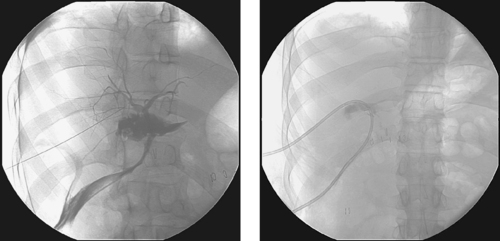 |
1. What problem is visualized in the first image?
2. Name two likely potential etiologies for this problem.
3. Is immediate percutaneous biliary drainage the best initial treatment option?
4. What biliary ductal variant is important to consider in patients presenting with postoperative bile leaks?
ANSWERS: CASE 108
Common Hepatic Duct Transection
1. Common hepatic duct transection with biloma formation.
2. Iatrogenic injury during laparoscopic cholecystectomy, and trauma.
3. Not necessarily. Biloma drainage is often a better and easier initial step.
4. Aberrant right posterior duct.
Reference
Saad, N.; Darcy, M., Iatrogenic bile duct injury during laparoscopic cholecystectomy, Tech Vasc Interv Radiol. 11 (2008) 102–110.
Cross-Reference
Comment
Bile duct injury is a dreaded complication of laparoscopic or open cholecystectomy, because in these situations, patients often require multiple radiologic interventions and/or complex surgical repair. The images here demonstrate contrast extravasating from the common hepatic duct and collecting as a biloma in the right subhepatic space and paracolic gutter. The distal common bile duct is not visualized, indicating a complete ductal transection.
The rate of technical failure of percutaneous biliary drainage is less than 5% in patients with dilated biliary ducts, but it can be as high as 25% in patients without ductal dilation. For this reason, in cases of major ductal injury, a percutaneous drainage catheter may first be placed within the easily accessible biloma to obtain initial control of the leak. After several weeks to a few months, a mature tract might form between the collapsed biloma cavity and the site of ductal injury. At this time, contrast injected into the biloma drain can opacify the biliary system, facilitating biliary drainage. In many cases, passage of a guidewire into the bowel is not possible; in these patients, a snare catheter may be used from the biloma access site to externalize the biliary wire and enable placement of a U-tube (second image), which is more stable than an external biliary drainage catheter. The presence of a drainage catheter assists the surgeon in identifying the duct during dissection, because there may be significant inflammation within the hepatic hilum. Ultimately, definitive surgical repair with hepaticojejunostomy is usually performed.
Case 109
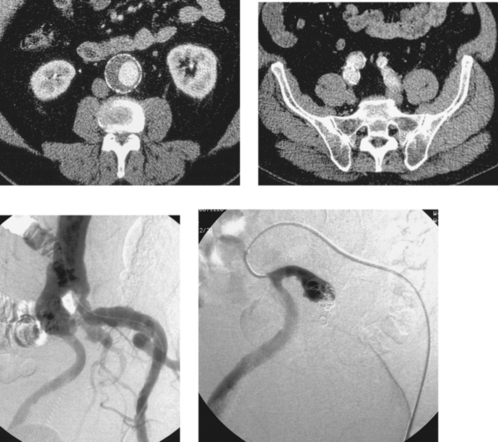 |
1. Describe the major finding in the first three images.
2. What treatment options exist for this problem?
3. What procedure was performed before the final image and why?
4. What significant clinical sequelae might this procedure produce?
ANSWERS: CASE 109
Internal Iliac Artery Embolization
1. Abdominal aortic aneurysm (AAA) extending into the right common iliac artery.
2. Surgical repair of an aneurysm or placement of a stent graft if the aneurysm is large enough to warrant treatment (generally 5cm, although 4-cm AAAs are treated by some).
3. Right internal iliac artery embolization, to prevent endoleak resulting from cross-pelvic collateral flow following stent-graft repair.
4. Ipsilateral buttock claudication and/or pelvic or colonic ischemia.
Reference
Cynamon, J.; Lerer, D.; Veith, F.J.; et al., Hypogastric artery coil embolization prior to endoluminal repair of aneurysms and fistulas: Buttock claudication, a recognized but possibly preventable complication, J Vasc Intervent Radiol. 11 (2000) 573–577.
Cross-Reference
Comment
A variety of anatomic issues must be addressed before placing a stent graft for AAA. First, the iliac arteries must be of suitable caliber (7–8mm) to permit introduction of the stent-graft delivery apparatus. Second, the proximal and distal necks of the aneurysm should be of sufficient length (>15mm) and diameter (device-specific but usually <26-30mm), and should be free of significant angulation or plaque, which can interfere with proper seating of the device. Third, the distance from the origin of the lowest renal artery to the origin of the internal iliac artery must be measured in order to select the proper device length.
When AAA involves the common iliac artery and the distal neck measures less than 15mm, the potential exists for late aneurysm rupture due to endoleak via cross-pelvic collaterals from the contralateral internal iliac artery. For this reason, ipsilateral internal iliac artery coil embolization is performed to prevent this. Two main postprocedural adverse sequelae exist: First, if the contralateral internal iliac artery and inferior mesenteric artery are severely diseased, colonic ischemia can result. Second, about 40% of patients experience buttock claudication after internal iliac artery embolization; although this resolves spontaneously in two thirds of patients within a year, it can be a lifestyle-limiting long-term problem in a minority of patients. The problems can be prevented to some degree by embolizing only the main trunk of the internal iliac artery and not its branches.
Notes
Case 110
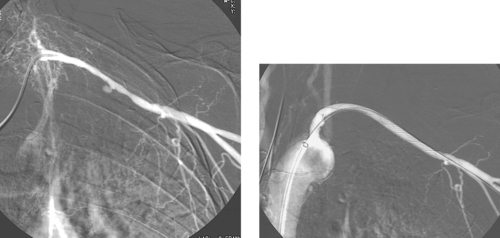 |
1. What study has been performed in the first image in this acutely bleeding patient with metastatic nodal disease in the left axilla?
2. What angiographic finding in the first image would explain the clinical findings?
3. What procedure has been performed before the second image?
4. Is this likely to represent a durable solution to this problem?
ANSWERS: CASE 110
Axillary Artery Stent-Graft Placement
1. Selective left subclavian arteriogram.
2. Pseudoaneurysm from the left axillary artery.
3. Stent-graft placement in the left axillary artery.
4. No. This procedure is palliative. Recurrent bleeding and/or stent-graft occlusion represent potential future problems.
Reference
Hilfiker, P.R.; Razavi, M.K.; Kee, S.T.; et al., Stent-graft therapy for subclavian artery aneurysms and fistulas: Single-center mid-term results, J Vasc Intervent Radiol. 11 (2000) 578–584.
Cross-Reference
Comment
In this case, hypervascularity is observed within the lower neck, consistent with the history of metastatic disease. A small pseudoaneurysm arises from the left axillary artery. Given the patient’s short life expectancy and the presence of tumor in this area, surgical repair would be undesirable and maybe impossible. For this reason, a stent graft was percutaneously inserted across the pseudoaneurysm, providing hemostasis.
The use of nonaortic stent grafts is increasing. Because the long-term durability of these devices has not yet been established, careful patient selection criteria must be used. However, this technology often enables treatment of very difficult surgical problems in a minimally invasive manner.
The stent component of a stent graft enables enlargement of a vascular lumen and facilitates graft fixation. The graft component of the stent graft enables one to reline the interior of a vessel wall. Current applications for these devices include: (1) Atherosclerosis: the graft lining is thought to be associated with lower restenosis potential than bare stents; (2) Peripheral aneurysms; (3) Trauma-related vascular injury in patients with high surgical risk; (4) Arteriovenous fistulas and similar lesions.
Case 111
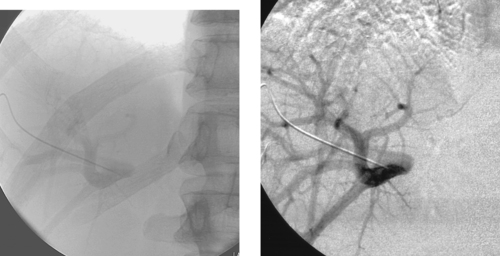 |
1. What vessel is being injected in the images above?
2. Why might this examination have been performed?
3. Name two major potential complications of this procedure.
4. How often is the portal vein bifurcation extrahepatic?
ANSWERS: CASE 111
Portal Vein Access for Islet Cell Transplantation
1. Right portal vein.
2. To guide a transjugular intrahepatic portosystemic shunt (TIPS) or to perform islet cell transplantation in diabetic patients.
3. Portal vein thrombosis and intraperitoneal hemorrhage.
4. Approximately 50% of patients.
References
Lin, J.; Zhou, K.R.; Chen, Z.W.; et al., 3D contrast-enhanced MR portography and direct x-ray portography: A correlation study, Eur Radiol. 12 (2003) 1277–1285.
Goss, J.A.; Soltes, G.; Goodpastor, S.E.; et al., Pancreatic islet transplantation: The radiographic approach, Transplantation 76 (2003) 199–203.
Cross-Reference
Comment
Direct portography via percutaneous catheter placement in the right portal vein for infusion of islet cells in a diabetic patient is depicted. Although this particular procedure is still investigational, direct portal vein access can be useful in a few clinical situations. When estimation of portal pressures is confounded by the presence of sinusoidal liver disease, a small catheter may be placed in the portal vein for direct pressure transduction. When transjugular portal vein access during TIPS is thought to be challenging, some physicians place a catheter within the right portal vein to provide a target for transhepatic puncture. In carefully selected patients, the percutaneous route may be used to clear thrombus from a thrombosed portal vein before placing a TIPS.
Case 112
 |
1. What is the minimum desired diameter for a stent placed in a renal artery?
2. How may stenosis in a small renal artery be treated?
3. If percutaneous and surgical revascularization are not possible owing to the small vessel size, what procedure can be used to ameliorate renovascular hypertension?
4. If it is unclear from angiography and scintigraphy whether a stenosis is causing renovascular hypertension, what procedure may be performed to clarify this?
ANSWERS: CASE 112
Stenosis in a Small Renal Artery
1. Below 6mm the significance of even mild degrees of intimal hyperplasia is great. Stent placement is not likely to lead to durable success in small vessels.
2. Percutaneous transluminal angioplasty, aortorenal bypass.
3. A renal artery supplying only a small amount of parenchyma may be embolized and that parenchyma sacrificed to treat renovascular hypertension.
4. Renal vein renin sampling.
Reference
Martin, L.G.; Cork, R.D.; Wells, J.O., Renal vein renin analysis: Limitations in predicting benefit for percutaneous angioplasty, Cardiovasc Intervent Radiol. 16 (1993) 76–80.
Cross-Reference
Comment
The images depict a stenosis in a fairly small renal artery. A poor technical result was observed after angioplasty (third image), so a stent was placed. The amount of renal parenchyma supplied by this renal artery was too large to sacrifice using embolization.
Essential hypertension is present in many patients with and without renal artery stenosis and is in fact a much more common etiology of hypertension than renovascular disease. For this reason, renovascular hypertension can be challenging to properly diagnose. Given the end-organ consequences of uncontrolled hypertension and the potential complications of renal artery interventions, this distinction is critical to make accurately.
Several adjuncts to anatomic diagnosis can help clarify whether a renal artery intervention should be performed. Direct arterial pressure measurements at the time of angiography determine if a significant (>10mm Hg systolic) pressure gradient is present across the stenosis. Captopril renal scintigraphy can demonstrate whether asymmetric renal perfusion is present, and it might also demonstrate the relative function of each kidney. Selective renal vein renin sampling that lateralizes to a kidney with a visualized renal artery stenosis can indicate the lesion’s clinical significance.
Notes
Case 113
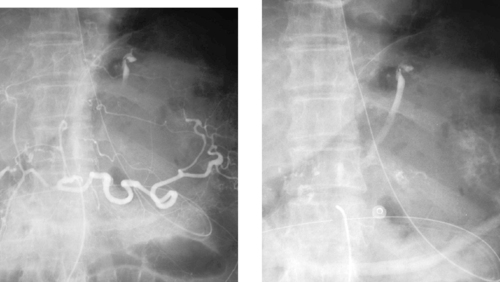 |
1. What is the diagnosis?
2. What artery most commonly supplies this region?
3. What embolization agent is preferred?
4. If endoscopic examination clearly visualizes a bleeding mucosal tear near the esophagogastric junction but no active extravasation is seen on angiography, what should be done?
ANSWERS: CASE 113
Mallory–Weiss Tear
1. Mallory–Weiss tear.
2. Left gastric artery.
3. Gelfoam.
4. The left gastric artery should be embolized anyway.
Reference
Morales, P.; Baum, A.E., Therapeutic alternatives for the MalloryWeiss tear, Curr Treat Options Gastroenterol. 6 (2003) 75–83.
Cross-Reference
Comment
A Mallory–Weiss tear is the most common nonvariceal source of bleeding at the esophagogastric junction. It most commonly results from a single linear nontransmural tear on the gastric side of the junction. The typical patient is an alcoholic who has suffered repetitive emesis. Therefore, endoscopy is critical to differentiate this disorder from variceal hemorrhage, a diagnosis that is also common in this patient population.
When endoscopic intervention fails to produce cessation of bleeding, arteriography is requested. Although focal accumulations of contrast medium may be seen lining the tear or the adjacent gastric folds (occasionally producing the pseudovein sign seen in the second image above), in many cases active contrast extravasation is not identified. Because of the rich collateral supply to the stomach via the gastroepiploic arteries, short gastric arteries, and right gastric artery, the left gastric artery can be embolized whether active extravasation is seen.
Case 114
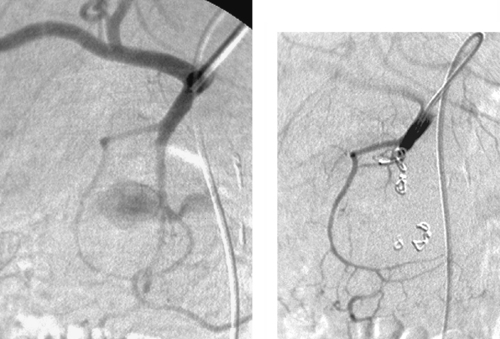 |
1. What vascular problem is pictured in the first image?
2. Name two common causes of this problem.
3. What treatment options are commonly used for this problem?
4. Is vasopressin infusion or embolization more likely to be effective?
ANSWERS: CASE 114
Bleeding Duodenal Ulcer
1. Gastroduodenal artery extravasation with pseudoaneurysm formation.
2. Duodenal ulcer, pancreatitis.
3. Endoscopic therapy, surgical treatment, and percutaneous embolization.
4. Embolization.
Reference
Levkovitz, Z.; Cappell, M.S.; Lookstein, R.; et al., Radiologic diagnosis and treatment of gastrointestinal hemorrhage and ischemia, Med Clin North Am. 86 (2002) 1357–1399.
Cross-Reference
Comment
Upper gastrointestinal (GI) bleeding is typically initially evaluated and managed with endoscopy. However, when endoscopic therapy fails, angiography may be indicated. The gastroduodenal artery runs immediately behind the first part of the duodenum. Consequently, ulcers penetrating its posterior wall can cause life-threatening arterial bleeding into the GI tract.
Depending upon the endoscopically determined location of bleeding, patients with upper GI bleeding are evaluated with selective arteriography of either the celiac artery (most of the time) or superior mesenteric artery. The parent catheter or a microcatheter can then be used to subselect the bleeding artery (in this case the gastroduodenal artery). If contrast extravasation is observed, embolization is performed using either Gelfoam or coils (second image). When using coils, it is important to be sure to embolize from distal to proximal to prevent backfilling of the ulcer from the gastroepiploic system (via the splenic artery) or the pancreaticoduodenal arcade (via the superior mesenteric artery). Given the intermittent nature of GI bleeding, if contrast extravasation cannot be confirmed, embolization of the gastroduodenal artery should still be performed if the endoscopic findings were clear or if the patient is unstable. Embolization therapy, while highly effective in producing initial cessation of bleeding and in stabilizing the patient, is less likely to provide a durable solution for large ulcers, and surgical therapy might ultimately be needed.
Case 115
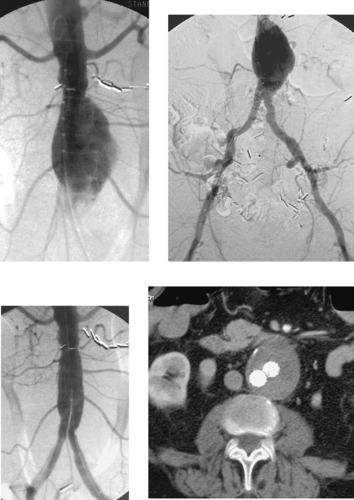 |
1. What procedure has been performed?
2. Is this procedure associated with less operative morbidity than open repair?
3. Name two procedure-related complications of this procedure.
4. Name three potential late complications of this procedure.
ANSWERS: CASE 115
Endoluminal Graft Repair of Abdominal Aortic Aneurysm
1. Endoluminal graft repair of abdominal aortic aneurysm (AAA).
2. Yes.
3. Iliac artery rupture, branch vessel occlusion.
4. Endoleak, graft limb occlusion, device migration.
Reference
Zarins, C.K.; White, R.A.; Schwarten, D.; et al., AneuRx stent graft versus open surgical repair of abdominal aortic aneurysms: Multicenter prospective clinical trial, J Vasc Surg. 29 (1999) 292–308.
Cross-Reference
Comment
Endovascular repair (stent-graft placement) of AAA has been increasingly used since 1991. Endovascular repair of AAA is associated with reduced hospital stay, periprocedural morbidity, and need for blood transfusions compared with open repair. By enabling treatment of patients with significant comorbidities, this procedure has expanded the range of patients who can be offered aneurysm repair. However, strict anatomic criteria must be used to select appropriate candidates for this procedure.
Advances in device technology have made it technically feasible to perform the procedure through a percutaneous approach without the need for femoral artery cutdown. Fluoroscopic guidance is used throughout the procedure. An aortogram is performed. Over a stiff wire, a large delivery sheath is carefully advanced into the aorta and, following repeat angiography, the trunk component is deployed with its upper end just below the lowest renal artery origin and expanded by angioplasty. The contralateral limb is catheterized from the other femoral artery, and repeat angiography is performed to define the distal neck of the contralateral side. The contralateral component is then deployed overlapping with the trunk component and expanded by angioplasty. Final angiography is performed to ensure that the graft limbs are patent, no endoleak is present, and all previously noted branch vessels are still patent (third image). The groins are then closed surgically if femoral cutdown was performed, or they are closed by percutaneous arterial closure devices if the procedure was performed in a completely percutaneous manner. After the procedure, patients are followed diligently with CT angiography (final image) and abdominal x-rays to evaluate for endoleak and late endograft migration.
Notes
Case 116
 |
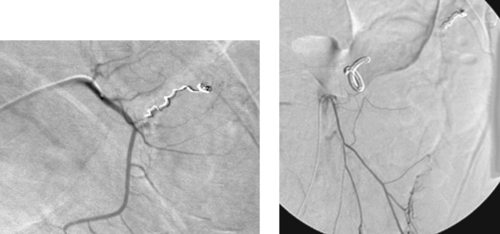 |
1. What problem is seen in this man with lower gastrointestinal bleeding (LGIB)?
2. What mesenteric branch vessels were successively catheterized?
3. Could vasopressin infusion have been performed to treat this abnormality?
4. How often is symptomatic ischemia observed following superselective colonic artery embolization?
ANSWERS: CASE 116
Embolization of Lower Gastrointestinal Bleeding
1. Focal contrast extravasation from a left colon diverticulum.
2. Superior mesenteric artery (SMA), middle colic artery, marginal artery.
3. Yes.
4. From 1% to 4% of cases.
Reference
Darcy, M.D., Treatment of lower gastrointestinal bleeding: Vasopressin infusion versus embolization, J Vasc Intervent Radiol. 14 (2003) 535–543.
Cross-Reference
Comment
Contraindications to vasopressin therapy for LGIB include coronary artery and cerebrovascular disease, arrhythmia, and severe hypertension. Vasopressin infusion has largely been replaced by coil embolization for treating LGIB. The main reason underlying this change is the development of microcatheter technology, which has enabled rapid catheterization of very small arterial branches and fairly easy traversal of tortuous vascular segments. Because colonic branches are often easy to catheterize rapidly, embolotherapy can be a fast way of obtaining hemostasis. Generally, coils are used for embolization of LGIB, although a variety of materials including Gelfoam and polyvinyl alcohol particles have also been used. Since the advent of superselective embolization using microcatheters, symptomatic ischemia following embolization has been extremely uncommon.
It is very important to account for the collateral supply in the bowel when treating GI bleeding. For example, the splenic flexure is usually supplied by a marginal artery that connects the SMA and inferior mesenteric (IMA) arterial circulations (third image). For this reason, in the case presented here, coils were placed in a branch of the marginal artery distal to the point of connection between the SMA and IMA circulations. Following embolization, the SMA and IMA (final image) were injected to confirm that hemostasis was achieved.
Notes
Case 117
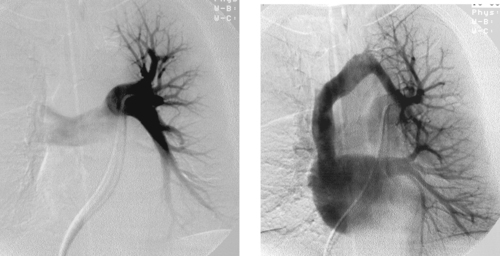 |
1. What vessels are opacified on the second image from this selective left pulmonary arteriogram?
2. What is the diagnosis?
3. Would this abnormality cause cyanosis?
4. Is this abnormality associated with congenital heart disease?
ANSWERS: CASE 117
Partial Anomalous Pulmonary Venous Return
1. Left upper-lobe pulmonary vein, left brachiocephalic vein, superior vena cava.
2. Partial anomalous pulmonary venous return (PAPVR).
3. No.
4. Yes.
Reference
Hong, Y.K.; Park, Y.W.; Ryu, S.J.; et al., Efficacy of MRI in complicated congenital heart disease with visceral heterotaxy syndrome, J Comput Assist Tomogr. 24 (2000) 671–682.
Cross-Reference
Comment
The true incidence of partial anomalous PAPVR is difficult to determine because many patients are asymptomatic. Symptoms typically arise from associated congenital heart defects or from increased pulmonary flow and right heart volume overload resulting from left-to-right shunting. Symptoms are rarely seen when less than 50% of pulmonary venous blood returns to the right atrium.
A number of congenital cardiac defects have been identified in association with PAPVR. The most common is an atrial septal defect, particularly when the PAPVR drains the right lung to the superior vena cava (SVC). Other associated cardiac defects include ventricular septal defect (VSD), tetralogy of Fallot, pulmonary valve atresia with VSD, aortic coarctation, common atrium, and single ventricle.
There are multiple forms of PAPVR, and one or several veins may be involved. The right lung is more commonly affected, and, rarely, both lungs are involved. The most common is an anomalous connection between the right upper-lobe pulmonary vein and the SVC. PAPVR from the right lower-lobe pulmonary vein to the inferior vena cava is called scimitar syndrome because of its classic plain film appearance.
Case 118
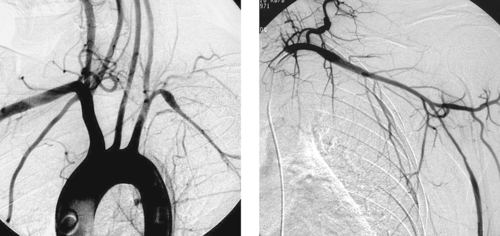 |
1. What is the probable diagnosis in this young patient?
2. Is this disorder more common in males or females?
3. In what situations can angioplasty be performed?
4. Can the pulmonary arteries be involved with this disease?
ANSWERS: CASE 118
Takayasu’s Arteritis
1. Takayasu’s arteritis.
2. Females more than males (3:1 ratio).
3. When flow-limiting stenosis is present and the patient’s inflammatory disease is not in an active phase.
4. Yes.
Reference
Weyand, C.M.; Goronzy, J.J., Medium- and large-vessel vasculitis, N Engl J Med. 349 (2003) 160–169.
Cross-Reference
Comment
Takayasu’s arteritis is a granulomatous vasculitis that primarily involves the thoracic and abdominal aorta and its large branch vessels. Because of infiltration of the adventitia with inflammatory cells, the luminal caliber of the vessel is compromised and fibrotic stenoses eventually develop. It is more common in women younger than 50 years. Patients characteristically have an elevated erythrocyte sedimentation rate, and approximately half exhibit constitutional symptoms in the acute inflammatory stage including myalgias, fatigue, low-grade fever, tachycardia, and pain adjacent to the inflamed arteries. Interestingly, there may be a 5- to 20-year interval between the onset of acute inflammatory symptoms and the development of symptomatic arterial occlusive disease. Patients typically present with neurologic symptoms, history of stroke, or asymmetric arm blood pressure measurements and/or pulses.
Aortography typically shows smooth concentric narrowing of the aorta and/or branch vessel stenoses or occlusions. In 75% of cases the aortic arch and branch vessels are affected. The left subclavian artery is commonly affected (55%), followed in decreasing order of frequency by the right subclavian artery, left common carotid artery, and right common carotid artery. In the case presented here, there is a smooth, elongated stenosis of the left axillosubclavian artery, a fairly characteristic appearance.
Case 119
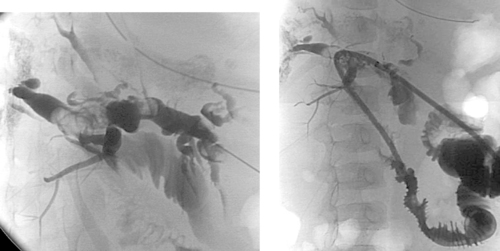 |
1. What surgical procedure has been performed?
2. What symptoms are probably present?
3. What abnormality is seen?
4. What is the probable etiology?
ANSWERS: CASE 119
Postoperative Biliary Calculi
1. Hepaticojejunostomy.
2. Right upper quadrant pain, jaundice, itching.
3. Globular filling defects within the right and left hepatic ducts.
4. Calculi or blood clots.
Reference
De Moor, V.; El Nakadi, I.; Jeanmart, J.; et al., Cholangitis caused by Roux-en-Y hepaticojejunostomy obstruction by a biliary stone after liver transplantation, Transplantation 75 (2003) 416–418.
Cross-Reference
Comment
The images demonstrate a surgical hepaticojejunostomy, in which the common hepatic duct was anastomosed to a loop of proximal small bowel. Several large, globular filling defects are present within the ducts, representing biliary calculi.
Patients with biliary–enteric anastomoses can develop several types of complications. The most significant early complication is anastomotic leakage. Also, early on, poor drainage of bile may be present during the first week due to edema at the biliary–enteric anastomosis.
Several potential late complications exist. The development of an anastomotic stricture can lead to episodes of cholangitis. Such strictures can be treated with prolonged biliary drainage and balloon dilation. The late complication pictured in the images here is the development of biliary calculi, which occurs in a small percentage of patients following this surgical procedure. Because the common presence of a Roux-en-Y limb can render endoscopic intervention impossible in many cases, percutaneous methods of removing or dislodging calculi are desirable in many such patients. With Roux-en-Y limbs, obstruction of the afferent loop also occurs in a small percentage of patients.
Notes
Case 120
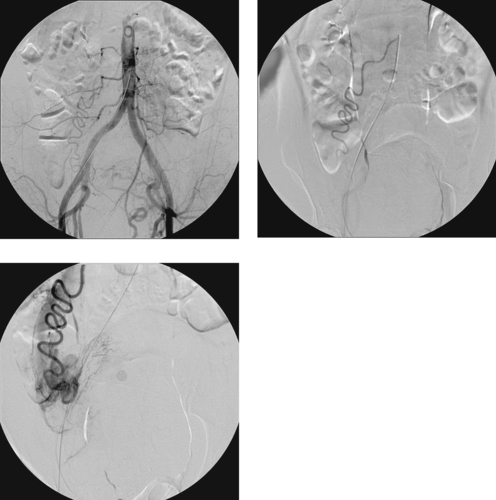 |
1. What percentage of patients do not exhibit clinical response following uterine fibroid embolization?
2. How is clinical success monitored after the procedure?
3. Name two potential causes of failure of uterine fibroid embolization.
4. Why did this patient fail uterine artery embolization and what can be done?
ANSWERS: CASE 120
Ovarian Artery Embolization
1. About 10% to 15%.
2. Patient history (to evaluate symptoms) and MRI (to evaluate fibroid and uterus size).
3. Uterine artery spasm, aberrant arterial supply to the fibroid uterus.
4. Supply to the fibroids via the right ovarian artery. This artery was embolized, resulting in clinical treatment success.
Reference
Worthington-Kirsch, R.L.; Andrews, R.T.; Siskin, G.P.; et al., Uterine fibroid embolization: Technical aspects, Tech Vasc Intervent Radiol. 5 (1) (2002) 17–34.
Cross-Reference
Comment
Uterine artery embolization has been shown to improve menorrhagia symptoms and pelvic pain in 85% to 90% of patients. There are several potential reasons why a minority of patients do not demonstrate clinical response after embolization. One potential reason is incomplete bilateral embolization. The most common reason this might occur is when arterial spasm-related slow flow in the uterine artery deceives the angiographer into believing that embolization has been achieved. Another common reason is the presence of additional blood supply to the fibroid uterus. This can result from congenital variations in uterine artery anatomy or to pelvic collateral supply.
The images here demonstrate the most common source of extrauterine supply to the uterus: an enlarged ovarian artery. In the first image, the right ovarian artery is clearly visualized on the nonselective aortic injection, confirming that it is abnormally enlarged. The final two images demonstrate the characteristic serpiginous appearance of the ovarian artery and its eventual supply to the right part of the uterine fundus.
Fortunately, the ovarian artery can also be embolized. Most interventionalists embolize the main ovarian artery using Gelfoam, although some advance a microcatheter beyond the ovary and attempt subselective embolization of the uterine branches.
Notes
Case 121
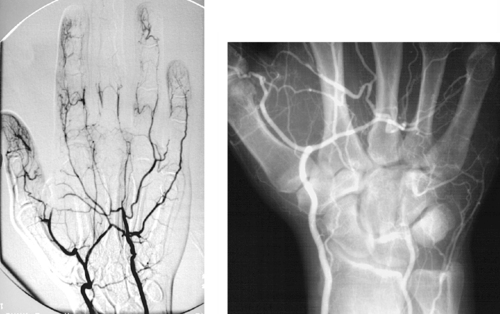 |
1. Which vessel is abnormal in these two patients?
2. What is the anatomic reason for this vessel’s vulnerability?
3. What anatomic factor is an important determinant of symptom severity?
4. Does this abnormality tend to produce distal embolization?
ANSWERS: CASE 121
Hypothenar Hammer Syndrome
1. Ulnar artery.
2. It can be compressed against the hook of the hamate.
3. The degree of completeness of the palmar arch.
4. Yes (see the first image above).
Reference
Anderson, S.E.; De Monaco, D.; Buechler, U.; et al., Imaging features of pseudoaneurysms of the hand in children and adults, Am J Roentgenol. 180 (2003) 659–664.
Cross-Reference
Comment
Hypothenar hammer syndrome is an uncommon cause of digital ischemia that occurs as a result of repetitive blunt trauma or mechanical vibration or pressure to the wrist or palm. Typically it is the result of occupational trauma (e.g., jackhammer operators), and it can be seen in persons who practice martial arts. Lesser forms of trauma, including repetitive microtrauma in typists or pianists, can also lead to digital ischemia.
The chronic trauma produces spasm and intimal injury resulting in thrombosis (second image) and/or formation of a pseudoaneurysm (first image). A pseudoaneurysm might serve as a source of emboli to the digital arteries (first image). Although other vessels can be affected, the ulnar artery is particularly vulnerable where it crosses the hamate bone and can be compressed.
The degree of symptomatology depends upon vessel patency, the presence of emboli, and the degree of completeness of the palmar arch. Symptoms include evidence of digital ischemia, Raynaud’s phenomenon, and/or a pulsatile mass.
Case 122
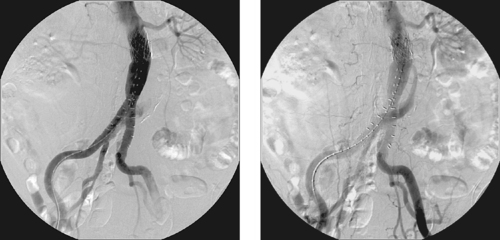 |
1. What endovascular procedure has been performed?
2. How are patients usually monitored following this procedure?
3. What abnormality is present on this angiogram?
4. Why is this significant?
ANSWERS: CASE 122
Type I Endoleak
1. Endoluminal graft insertion.
2. Periodic cross-sectional imaging with CT angiography using noncontrast, arterial phase contrast-enhanced, and delayed postcontrast imaging.
3. Type I endoleak from the right distal attachment site.
4. Potential for aneurysm rupture.
Reference
Tummala, S.; Powell, A., Imaging of endoleaks, Tech Vasc Intervent Radiol. 4 (4) (2001) 208–212.
Cross-Reference
Comment
An endoleak is defined as the persistence of blood flow outside the graft within the aneurysm sac following endoluminal repair. An aneurysm sac that is completely excluded from flow typically thromboses and often shrinks in diameter. The presence of perigraft flow leaves the aneurysm at risk for enlargement and/or rupture. The images here clearly depict a type I leak, with filling of the aneurysm sac on the second image.
Endoleaks are classified by type. Type I endoleaks result from flow around the ends of the endograft and are subdivided into type IA (proximal attachment site leak) and IB (distal attachment site leak). These endoleaks require urgent therapy. Type II endoleaks are the most common and result from retrograde arterial flow into the aneurysm sac from patent aortic side-branches (typically lumbar, sacral, gonadal, accessory renal, or inferior mesenteric artery branches). The criteria upon which to base treatment of type II endoleaks are controversial. Some physicians treat all type II leaks via side-branch embolization or glue embolization of the aneurysm sac, and others believe that watchful waiting is sufficient provided the aneurysm is not enlarging. Type III endoleaks are rare and result from tears in the graft fabric or separation of graft components. Type IV endoleaks represent leakage of contrast due to porosity of the graft fabric material.
Case 123
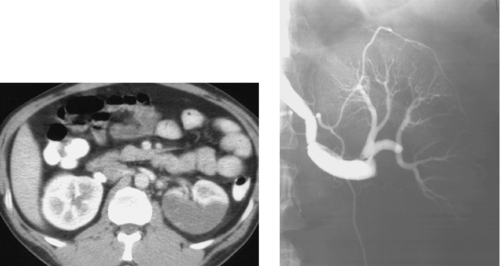 |
1. What abnormality is seen on the CT scan of this young woman with acute left flank pain?
2. What is the cause of this patient’s pain?
3. What is the most common cause of this problem when it occurs spontaneously?
4. What is the most common overall cause of this problem?
ANSWERS: CASE 123
Spontaneous Renal Artery Dissection
1. Severe hypoperfusion of the posterior part of the left kidney.
2. Left renal artery dissection.
3. Fibromuscular dysplasia.
4. Iatrogenic renal artery injury during angioplasty.
Reference
Muller, B.T.; Reiher, L.; Pfeiffer, T.; et al., Surgical treatment of renal artery dissection in 25 patients: Indications and results, J Vasc Surg. 37 (2003) 761–768.
Cross-Reference
Comment
The second image demonstrates apparent enlargement and double-density of the left renal artery with a proximal focal indentation consistent with a renal artery dissection. The flap extends to the bifurcation of the main left renal artery, and its posterior division is occluded. This explains the marked left kidney hypoperfusion on CT.
Renal artery aneurysm and/or renal artery dissection occur in a minority of patients with fibromuscular dysplasia. Given the rarity of other etiologies of these lesions, however, a patient with an unexplained renal artery aneurysm or dissection is highly likely to have underlying fibromuscular dysplasia.
Patients with spontaneous renal artery dissection are nearly always managed with surgical aortorenal arterial bypass. In patients who are poor candidates for surgery, stents can be used to treat focal dissections limited to the main renal artery.
Case 124
 |
1. What vessel is selectively opacified?
2. What abnormality is present?
3. Where is this abnormality most likely located?
4. What is the most likely reason this angiogram was performed?
ANSWERS: CASE 124
Small Bowel Leiomyoma
1. Superior mesenteric artery.
2. A well-circumscribed, bilobed enhancing mass.
3. Small bowel.
4. Evaluation of chronic lower gastrointestinal bleeding.
Reference
Lefkovitz, Z.; Cappel, M.S.; Kaplan, M.; et al., Radiology in the diagnosis and therapy of gastrointestinal bleeding, Gastroenterol Clin North Am. 29 (2000) 489–512.
Cross-Reference
Comment
Many patients develop chronic GI blood loss but have negative workups, including upper and lower endoscopies, small bowel follow-through, and tagged RBC scintigraphy. In such cases, angiography can sometimes help to identify an occult vascular lesion such as angiodysplasia or a small bowel tumor, with the goal of providing guidance for surgical resection. Owing to the intermittent low-grade bleeding associated with these lesions, extravasation of contrast is not typically seen during angiography.
Although small bowel tumors are rarely seen at arteriography, an understanding of their basic imaging features is useful to have. Leiomyomas like the one depicted here have a characteristic appearance with well-circumscribed margins, prominent feeding arteries and draining veins, and irregular corkscrew tumor vessels with a dense tumor stain. Most are benign, although malignancy cannot be excluded on imaging. The most common primary tumor of small bowel is carcinoid. Owing to its prominent desmoplastic reaction within the mesentery, characteristic angiographic findings include retraction, displacement, and occlusions of multiple superior mesenteric artery branches. Hamartomas and adenocarcinomas typically appear hypovascular. Lymphomas have no characteristic findings. They can demonstrate vascular displacement or encasement but are often undetectable despite widespread involvement.
Case 125
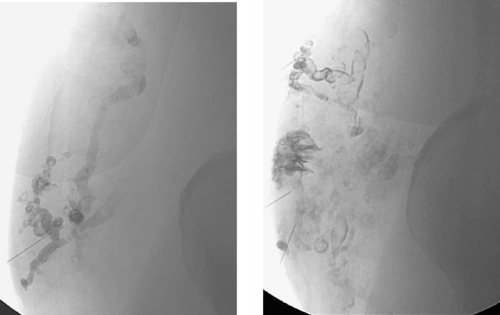 |
1. Why might this patient have presented for evaluation and treatment?
2. What is the most likely diagnosis?
3. What is the first-line imaging method of choice for these lesions?
4. How can this be treated percutaneously?
ANSWERS: CASE 125
Venous Malformation
1. Local pain and swelling; in this 21-year-old police officer, his gunbelt was very uncomfortable.
2. Venous malformation.
3. Magnetic resonance imaging.
4. Direct injection of a sclerosant such as 100% ethanol.
Reference
Lee, B.B.; Do, Y.S.; Byun, H.S.; et al., Advanced management of venous malformation with ethanol sclerotherapy: Mid-term results, J Vasc Surg. 37 (2003) 533–538.
Cross-Reference
Comment
Vascular malformations are congenital lesions that grow periodically, often in relation to trauma, surgery, or hormonal stimulation (via puberty, pregnancy, or hormonal therapy). Vascular malformations are typically categorized into arterial, capillary, venous, lymphatic, and mixed subtypes. MRI is useful to determine the depth and extent of these lesions as well as their proximity to normal structures. MRI is also useful in the imaging follow-up after treatment because multiple ablation sessions are often necessary.
Owing to the presence of an intervening capillary network, the inflow arteries to venous malformations, like the one depicted, are normal in size. Flow within these dilated abnormal veins tends to be slow or stagnant, and calcified phleboliths may be identified.
Small, asymptomatic venous malformations in the extremities are treated conservatively with compressive stockings and follow-up. Surgical resection is not indicated owing to the difficulty in extricating these delicate vascular structures from surrounding normal tissues. Sclerotherapy is favored, and absolute ethanol is the agent preferred by many. After the lesion is directly punctured with a needle, contrast is injected to confirm needle placement and determine the volume necessary to fill the lesion. A similar volume of ethanol is then injected and allowed to dwell in the lesion for about 10 minutes. Follow-up venography is performed to confirm thrombosis of the lesion.
Case 126
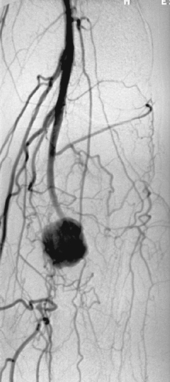 |
1. What findings are present on this magnified arteriogram at the knee level?
2. What is the most likely cause based solely upon the angiographic findings?
3. What might this lesion represent if the patient is an intravenous drug abuser?
4. What symptoms might be present if that was the case?
ANSWERS: CASE 126
Mycotic Aneurysm
1. Irregular distal popliteal artery aneurysm with occlusion of the tibial arteries.
2. Post-traumatic pseudoaneurysm.
3. Mycotic aneurysm.
4. Fever, local tenderness, positive blood cultures, and/or expanding mass.
Reference
Patra, P.; Ricco, J.; Costargent, A.; et al., Infected aneurysms of neck and limb arteries: A retrospective multicenter study, Ann Vasc Surg. 15 (2001) 197–205.
Cross-Reference
Comment
Infectious (mycotic) aneurysms can occur anywhere in the arterial system. The usual cultured infectious organisms are Salmonella, Streptococcus, or Staphylococcus species, and the latter is commonly found in intravenous drug abusers.
Mycotic aneurysms represent an infection of the artery wall itself either caused by seeding of a preexisting aneurysm or by primary infection of a normal artery with subsequent dilation. The infection can be introduced from infected blood in the lumen or vasa vasorum, by spread from a neighboring soft tissue infection, or from penetrating trauma. Therefore, mycotic aneurysms can be true or false aneurysms and may be single or multiple depending upon the underlying condition of the vessel and the method of infection. The symptomatology and angiographic appearance can differentiate these from degenerative aneurysms. The mycotic aneurysm sac is typically irregular, saccular, and eccentric, and the arterial system is less likely to show chronic atherosclerosis.
Treatment consists of antibiotics, surgical resection of the aneurysm, débridement of infected tissues, and drainage of the infected region. In some cases the artery can be ligated, but when revascularization is necessary, an extra-anatomic bypass can often be performed to avoid the infected region. In some cases, an anatomic bypass can successfully be performed with autogenous materials (native veins) or cryopreserved allografts if success in clearing of infection with antimicrobial agents is anticipated. Prosthetic material should not be inserted into a known infected space.
Case 127
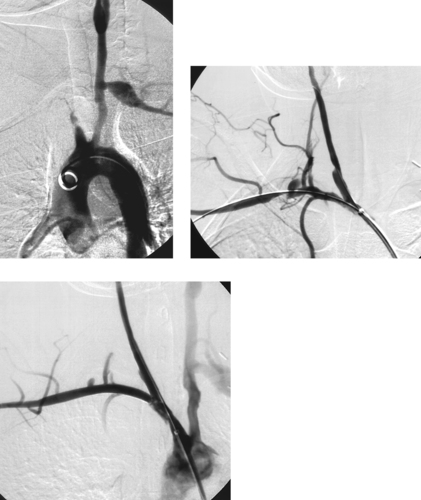 |
1. What is the underlying diagnosis?
2. What procedure has been performed in the second and third images?
3. Is this the first-line treatment for this problem?
4. What is the expected 5-year patency of surgical carotid–subclavian bypass in patients with atherosclerosis?
ANSWERS: CASE 127
Brachiocephalic Artery Stent Placement
1. Takayasu’s arteritis.
2. Stent placement in the innominate, right common carotid, and right subclavian arteries.
3. No. Carotid–subclavian bypass is the first-line treatment.
4. More than 95%.
Reference
Sharma, B.K.; Jain, S.; Bali, H.K.; et al., A follow-up study of balloon angioplasty and de-novo stenting in Takayasu arteritis, Int J Cardiol. 75 (Suppl) (2000) S147–S152.
Cross-Reference
Comment
Patients with Takayasu’s arteritis can present complex management problems. Typically they are first managed with anti-inflammatory therapy until arterial symptoms develop. At this point, surgical bypass is the usual therapy employed, although angioplasty and/or stent placement can also be used for focal, short-segment lesions that are in a chronic phase. Surgery or interventional therapy in the acute inflammatory stages should be avoided owing to lower rates of long-term success.
If the brachiocephalic artery or proximal subclavian artery is occluded and the ipsilateral common carotid artery is normal, reimplantation of the subclavian artery into the carotid or carotid–subclavian bypass is the preferred operation. If the carotid artery is diseased, it is replaced with graft material, and the subclavian artery is implanted into the graft or grafted to the aorta or carotid graft.
In the case presented here, the patient had been operated on multiple times for the brachiocephalic artery occlusion and had multiple occluded bypass grafts. Because she was thought to be a poor risk for further intervention in the same operative bed, an endovascular stent was placed.
Notes
Case 128
 |
1. This patient presented with constant abdominal pain 6 weeks after an episode of acute pancreatitis. What is the diagnosis?
2. Do all patients with this diagnosis need interventional treatment?
3. What approaches can be used for draining these lesions?
4. Will this tube be ready to remove within 2 weeks?
ANSWERS: CASE 128
Transgastric Pancreatic Pseudocyst Drainage
1. Pancreatic pseudocyst.
2. No.
3. Percutaneous transabdominal if a suitable window is present, percutaneous transgastric, endoscopic internal drainage, surgical drainage.
4. No. Pseudocyst drains are often in for months.
Reference
Neff, R., Pancreatic pseudocysts and fluid collections: Percutaneous approaches, Surg Clin North Am.
Buy Membership for Cardiovascular Category to continue reading. Learn more here







